
Complete Overland Track packing list: what to pack for Tasmania’s best multi-day hike
Tasmania’s Overland Track is a 6-day wilderness adventure through cradle-shaped mountains, misty rainforest, and button-grass plains, undoubtedly the best multi-day hike in Australia. The scenery is wildly diverse, and so is the weather— which means you’ll need gear that’s adaptable, weatherproof, and built to handle wet, muddy conditions.
I hiked the Overland Track in January 2019, camping every night and carrying all of my own food, shelter, and gear. This post details the exact packing list I used— plus what I’d add, remove, or swap next time— whether you’re setting out in summer or shoulder season, solo or with a group.
This post contains affiliate links, which means I may earn a small commission if you purchase something I recommend, at no extra cost to you. I ONLY recommend gear that I personally use (or that James uses) and that we genuinely LOVE— your support helps keep this site going and the adventures rolling!
Check out my outdoor gear guides for the best:
Overland Track packing list
Tasmania’s Overland Track is usually hiked between November and April, when conditions are warmest and most stable. But this is still alpine Tasmania, where four seasons in a day is standard— so your gear needs to handle cold rain, deep mud, intense sun, and sudden cold snaps even in the middle of summer.
Expect daytime temperatures between 10–20°C (50–68°F), with nights dipping to 2–8°C (36–46°F), and colder at elevation or during storms. Rain is common, trails can be flooded or icy depending on the day, and snake sightings are frequent in summer, so you’ll want to be vigilant, especially in grassy or exposed areas.
There are basic public huts along the Overland, but they are first-come, first-serve and space is limited. While it may be tempting to rely on the huts, it’s strongly advised to carry your own camping gear in case no bunks are available! Huts are unserviced and offer no food, so you’ll also need to carry a full backcountry kitchen setup and all meals. This list is written for camping the full route, with gear that kept me warm, dry, and safe across Tasmania’s spectacular but wildly unpredictable terrain.
⛰️ Check out my Overland Track Guide for a detailed daily route description, trip logistics & real-world tips on tackling Tasmania’s best multi-day hike!
TRAIL ESSENTIALS
⭐️ backpack (50-75L): Osprey Aura AG 50 (Women’s) / Atmos AG 50 (Men’s)
⭐️ raincover: REI Co-op Duck’s Back Pack Rain Cover
⭐️ summit pack: REI Co-op Flash 18
⭐️ hiking boots: Salomon Quest 4 GTX Hiking Boots (women’s) / (men’s)
⭐️ trekking poles: Black Diamond Trail Trekking Poles
CAMPING GEAR
⭐️ backpacking tent: Nemo Dragonfly OSMO 3P
⭐️ sleeping bag: Sea to Summit Spark 0
⭐️ sleeping pad: Therm-a-Rest NeoAir XLite NXT Sleeping Pad
⭐️ camp pillow: Sea to Summit Aeros Premium
CAMP KITCHEN, WATER STORAGE & FOOD
⭐️ camp stove (+ fuel): Jetboil Zip
⭐️ mess kit + cutlery: Sea to Summit Frontier Ultralight Collapsible 4-Piece Dinnerware Set
⭐️ water filter: Katadyn BeFree 1.0L Water Filter
⭐️ water reservoir: HydraPak Seeker 2L
⭐️ water bottle: Nalgene Wide Mouth
⭐️ electrolytes: Liquid IV
⭐️ freeze-dried meals + snacks: see my complete guide to backcountry food
SAFETY & NAVIGATION
⭐️ PLB/SOS: Garmin InReach Mini 2
⭐️ GPS: CalTopo app on mobile & Garmin fenix 7X Pro Watch
⭐️ First Aid Kit: Adventure Medical Kits Backpacker
⭐️ headlamp: Black Diamond Spot 400-R
⭐️ powerbank: VRURC Portable Charger with Built-in Cables, 10000mAh
⭐️ solar charger: BigBlue 28W Solar Charger
TOP + BOTTOM LAYERS
⭐️ sports bra + underwear
⭐️ hiking shirt: Arc’teryx Taema Crew Shirt (women’s) / Cormac Crew Shirt (men’s)
⭐️ sun shirt: Arc’teryx Taema Hoody (women’s) / Cormac Hoody (men’s)
⭐️ wool base layer: Smartwool Classic Thermal Base Layer Top (women’s) / (men’s)
⭐️ lightweight fleece mid-layer: Arc’teryx Rho LT Hoody (women’s) / (men’s)
⭐️ synthetic insulation: Arc’teryx Atom Hoody (women’s) / (men’s)
⭐️ down jacket: Arc’teryx Cerium Hoody (women’s) / (men’s)
⭐️ shell jacket: Arc’teryx Beta SL Jacket (women’s) / (men’s)
⭐️ hiking shorts: Lululemon Align shorts
⭐️ fleece mid-layer bottoms: Arc’teryx Kyanite Base Layer Bottoms (women’s) / (men’s)
HEAD, HANDS & FEET
⭐️ sun hat: Arc’teryx Gamma 5-Panel Cap
⭐️ sunglasses: Julbo Vermont
⭐️ neck gaiter: Buff Original
⭐️ beanie: Arc’teryx Mallow Toque
⭐️ lightweight hiking gloves: Outdoor Research Trail Mix Gloves (women’s) / (men’s)
⭐️ waterproof shell mittens: Black Diamond Waterproof Overmitts
⭐️ liner socks: Injinji Liner Crew
⭐️ boot socks: Darn Tough Hiker Micro Crew Cushion Socks (women’s) / (men’s)
⭐️ camp shoes: Teva Original
PERSONAL ITEMS
⭐️ toiletries + bathroom bits
⭐️ Kula Cloth (for women)
⭐️ sun safety
⭐️ camera: Fujifilm x100vi
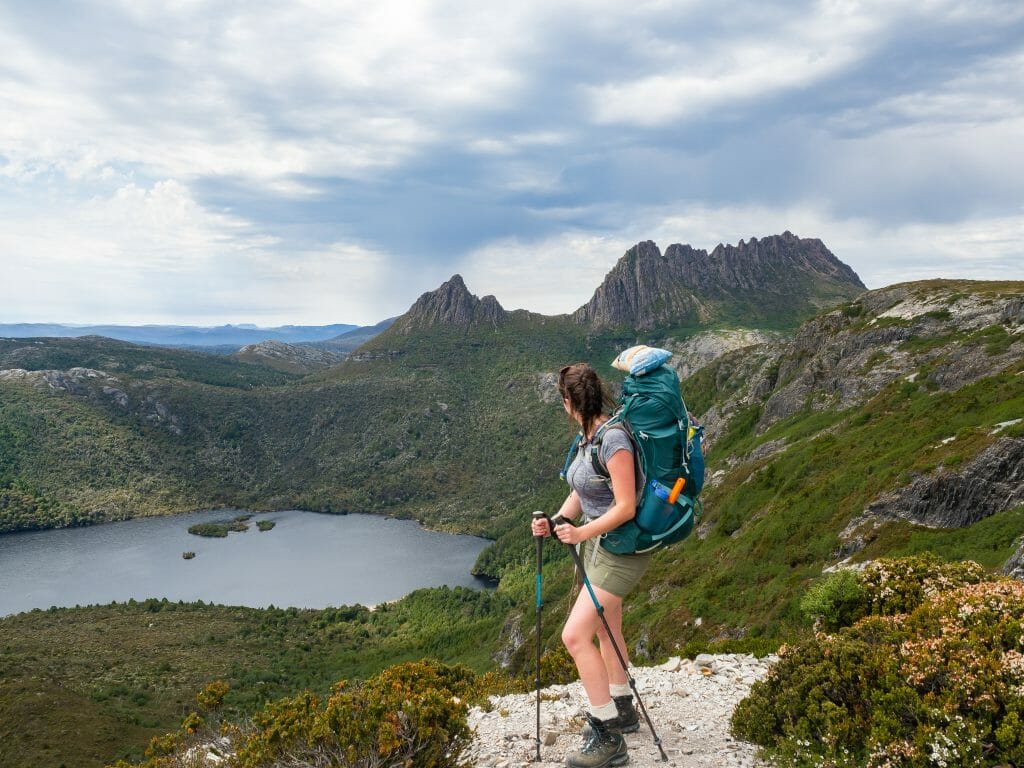
Trail essentials: backpack, boots & poles
Tasmania’s Overland Track throws a bit of everything at you— mud, roots, rainforest humidity, alpine winds— and a solid kit is key to keeping you comfortable through it all. These trail essentials helped me move efficiently, stay dry, and enjoy every muddy step of the adventure.

backpack (50-75L): Osprey Aura AG 50 (women’s) / Atmos AG 65 (men’s)
This is my absolute favourite backpack and I recommend it to everyone— 50L is great for 6 days, but some people may be more comfortable with the 65L version.
👉🏼 Need more advice on choosing a backpack? Check out this post: How to choose the best hiking backpack for every outdoor adventure

raincover: REI Co-op Duck’s Back Pack Rain Cover
Protects your gear from sudden downpours— some packs come with one built-in, but if not, make sure to pack a lightweight rain cover that fits over your bag (REI’s size medium or large should work best, depending on your pack capacity).

summit pack: REI Co-op Flash 18
If you plan to get off the main Overland Track and enjoy any side summits or viewpoints, a lightweight summit pack is a great addition to avoid carrying your full pack everywhere. This should roll up and stow easily!

hiking boots
I personally used Salomon Quest 4 GTX boots and they worked beautifully on the Overland Track, but I’ve since swapped over to a lighter hiking boot that still offers excellent ankle support and waterproofing. This is what I’d wear if I did the Overland again!
👉🏼 Need more advice on choosing the right boot? Read my outdoor footwear guide

trekking poles: Black Diamond Trail Trekking Poles
Trekking poles saved my knees on steep descents, provided balance across slippery roots and boardwalks, and made bog crossings way less sketchy.
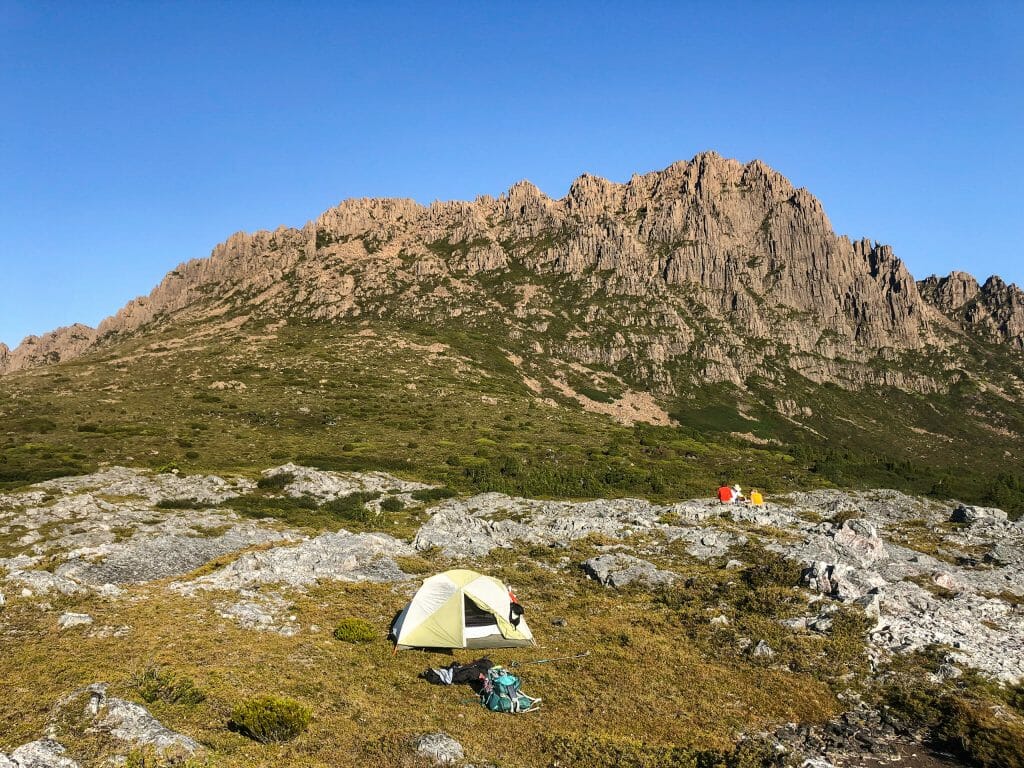
Camping gear
While there are basic huts along the Overland Track, they’re first-come, first-served, and camping gear is a mandatory backup. Expect wet ground, cold nights, and the need for fast setup in unpredictable Tassie weather!
I wrote two super detailed guides to help you choose the best backcountry camping setup based on a decade of international, multi-day backpacking experience everywhere from Patagonia to the Peruvian Andes to the Australian coast.
👉🏼 How to choose the best backpacking tent for your next adventure
👉🏼 How to choose the best outdoor sleep system: sleeping bags, sleeping pads & camp pillows

backpacking tent: Big Agnes Tiger Wall UL2 (solo hikers) or Nemo Dragonfly OSMO 3P (for 2 sharing)
I used an old 2-person Quarter Dome on the TMB, but tent materials have gotten a lot better since 2019, so I’d definitely recommend the Big Agnes Tiger Wall UL2 for solo hikers or couple who don’t mind getting super close! For upgraded interior space, James and I love our Nemo Dragonfly OSMO 3P for 2 people.

sleeping bag: Sea to Summit Spark 0
Temps can swing wildly, and having a zero-degree bag meant I never worried about being underprepared when the wind howled all night.

sleeping pad: Therm-a-Rest NeoAir XLite NXT Sleeping Pad
My favourite ultra-lightweight pad that’s still comfortable enough for a full 8hr sleep on the trail!

camp pillow: Sea to Summit Aeros Premium
A luxury I’ll never hike without! Lightweight, compact, and so worth the space for better sleep in the tent.
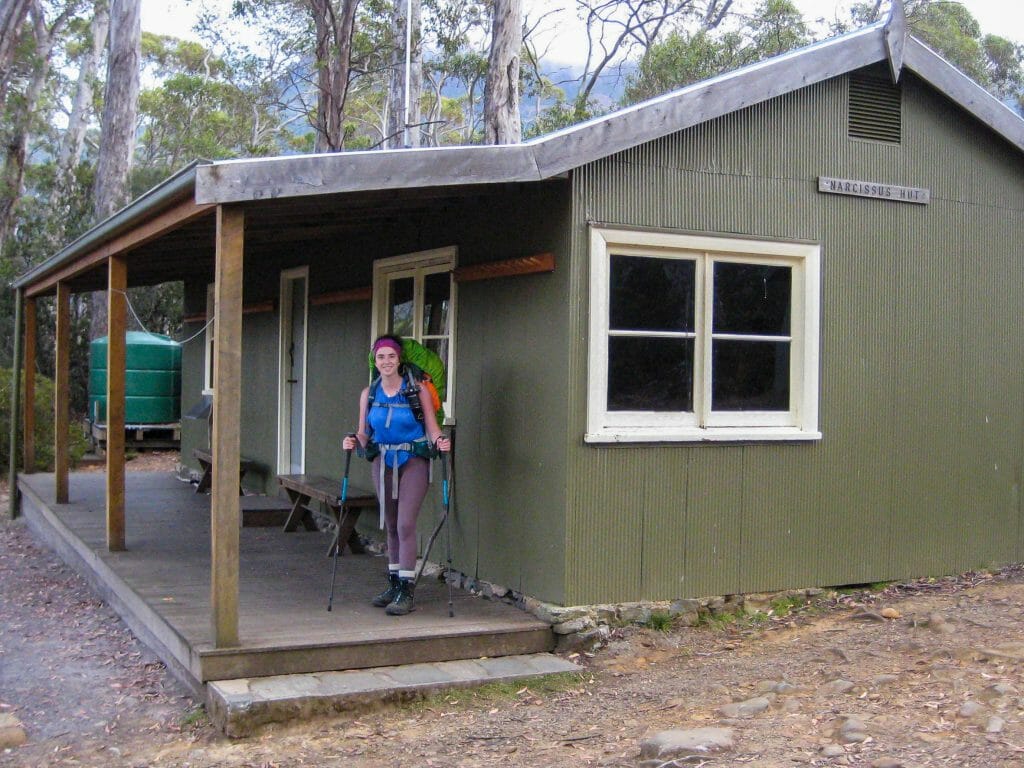
Camp kitchen, water storage & food
Huts provide shelter but no kitchen facilities or meals, so you’ll need to carry all your own food and full cooking gear for the entire trek.

camp stove (+ fuel): Jetboil Zip
A compact canister stove is ideal for making simple meals— crazy fast, fuel-efficient, and effective in heavy wind.
A conservative estimate for fuel is one 230g canister per 3 days per person, but I find this is way more than I use. Two people should be able to share a canister for the entire trek if you’re conservative with boiling.

mess kit + cutlery: Sea to Summit Frontier Ultralight Collapsible 4-Piece Dinnerware Set
At the very minimum, your mess kit should contain a spoon and cup; at most, it might extend to a bowl and fork.

water filter: Katadyn BeFree 1.oL Water Filter
There are heaps of creeks, tarns, and hut tanks along the trail, so it’s easy to find water sources to refill your bottles from. Carry a filter to be cautious.

water reservoir: HydraPak Seeker 2L
On top of your filter and your water bottle, backpacking trips call for a water reservoir— a lightweight, collapsible container used to haul dirty water from a stream or lake back to camp. Use it to fill pots for dinner or filter into bottles without crouching over a creek for 10 minutes! Lightweight, packable, and seriously practical when you’re dry camping or need to filter for multiple people.

2x water bottles: Nalgene Wide Mouth
I personally don’t like bladders on overnight trips since they can be especially challenging to fill when you’re filtering water (and the consequences of leakage can be catastrophic if it soaks your sleeping bag), so instead I pack 1-2 standard Nalgene bottles. As you like it!

electrolytes: Liquid IV
With constant sun exposure during the Aussie summer, I’d recommend drinking a minimum of 1 bottle of electrolyte-enriched water per day!

freeze-dried meals + snacks
Pack whatever you need for 6 days on the trail without any restocks.
👉🏼 Check out this post for a breakdown on how I pack backcountry food for alpine expeditions

Safety & navigation
Even though the Overland Track is well-travelled, Tasmania’s weather and remoteness mean you need to be completely self-sufficient. Heavy fog, rain, and even summer snowstorms are not unusual, and some sections are extremely isolated.

PLB/SOS: Garmin InReach Mini 2
A Personal Locator Beacon (PLB) is your lifeline in the outdoors and I NEVER go hiking without my Garmin InReach Mini 2, which allows me to send messages, get weather updates, track location, and place an SOS call in an emergency, even without phone service. It does require a subscription (starting at $12/month), but it’s worth every cent and has literally saved both of my parents’ lives in the backcountry!

The absolute best GPS resource is the smartphone you already own, paired with a reliable, low-cost GPS mapping app that allows you to access detailed offline Topo maps and navigate via GPS satellites, even without mobile service.
My go-to is CalTopo, which costs just $20/year and is by far the most feature-rich, affordable, and accurate mapping tool out there.

First Aid Kit: Adventure Medical Kits Backpacker
All the usual essentials:
• a mix of NSAIDs (ibuprofen, naproxen)
• antihistamines (Claritin for allergies, Benadryl for bites/stings)
• a small selection of stomach meds (like Imodium or Pepto tabs)
• a roll of KT tape (insanely versatile for everything from blisters to rolled ankles)
• alcohol wipes, antiseptic, a few large gauze pads, and blister plasters like Compeed

headlamp: Black Diamond Spot 400-R
A bright, rechargeable headlamp is essential for evenings around camp and (hopefully not) late nights on the trail. Lightweight and easy to stash in a top pocket for quick access!

powerbank: VRURC Portable Charger with Built-in Cables, 10000mAh
I used my phone constantly for navigation and photos, plus needed power for my inReach and headlamp. I carried a 10,000mAh powerbank and a solar charger, which was just enough to stay topped up on the Overland.

solar charger: BigBlue 28W Solar Charger
On multi-day trips with no access to power, a lightweight solar charger can be a great alternative to carrying multiple powerbanks. I definitely recommend one on the Overland to top up your phone, inReach, and headlamp during sunny lunch breaks— just enough to stay comfortably powered without the extra weight.
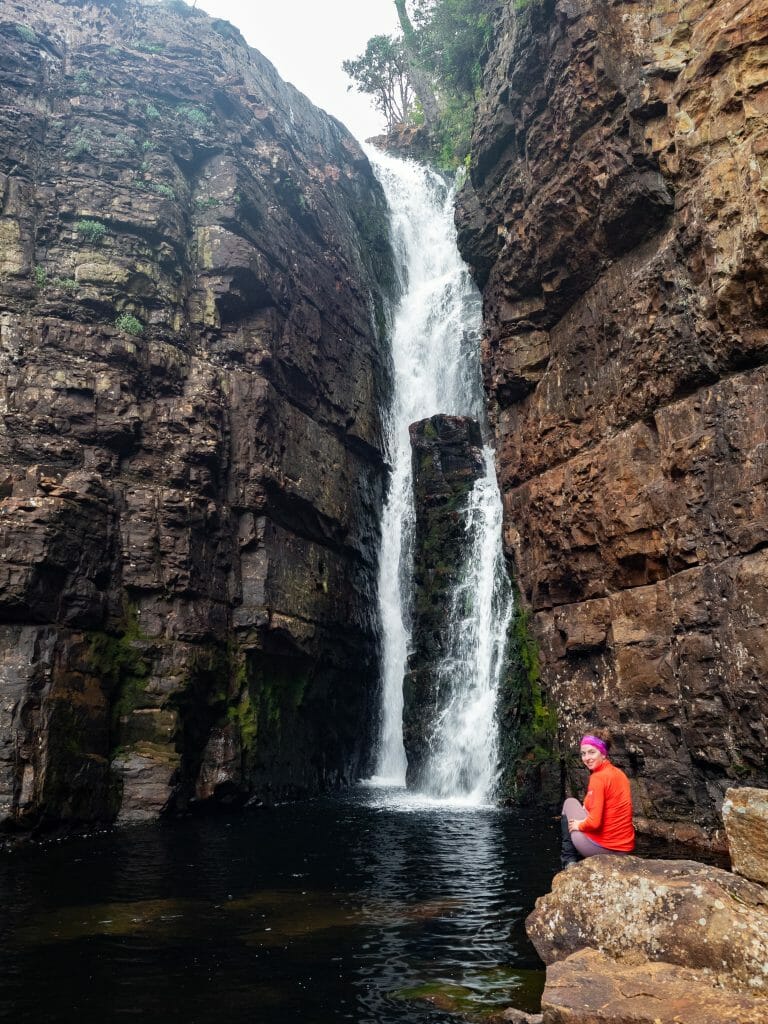
Top + bottom layers
Tasmania’s Overland Track dishes up classic “four seasons in a day” weather— you might start in misty rain, hike under blazing sun, and arrive at camp in a freezing gale. A smart, flexible layering system is the only way to stay dry, warm, and comfortable from start to finish.
👉🏼 Need help building a layering system that actually works? Read my outdoor layering guide for tips on choosing base layers, insulation, and outer shells.

sports bras + underwear
I’m not going to tell you what undergarments to pack, but just consider you’ll have 6 days on the trail and it’s very nice to have clean underwear every day!

hiking shirt: Arc’teryx Taema Crew Shirt (women’s) / Cormac Crew Shirt (men’s)
I’d suggest bringing just one shirt and washing it in a river partway through the trek to keep things ultra-light.

sun shirt for approach: Arc’teryx Taema Hoody (women’s) / Cormac Hoody (men’s)
Breathable, quick-drying, and UPF-rated to protect from the intense Australian sun. This is a great daily layer on the Overland!

wool base layer: Smartwool Classic Thermal Base Layer Top (women’s) / (men’s)
I used this as a camp base-layer (and didn’t wear it for any hiking) in an attempt to keep it as clean as possible. Warm, breathable, and perfect for multi-day wear without smelling awful.

lightweight fleece mid-layer: Arc’teryx Rho LT Hoody (women’s) / (men’s)
For hiking, this was the first layer I’d pull on over my t-shirt— lightweight, breathable, and just the right amount of warmth for long climbs or breezy afternoons without overheating. The hood adds a nice bit of extra insulation.

synthetic insulation: Arc’teryx Atom Hoody (women’s) / (men’s)
The Atom Hoody was my go-to insulation layer for contending with that variable Tassie weather.

down jacket: Arc’teryx Cerium Hoody (women’s) / (men’s)
The Arc’teryx Cerium Hoody came out at camp and for extra-cold mornings. Lightweight, packable warmth that felt amazing after a long, wet day on trail.

shell jacket: Arc’teryx Beta SL Jacket (women’s) / (men’s)
You’ll use this as much for wind protection as for actual rain in Tassie— a shell puts in long hours on the Overland, thanks to the wild fluctuations in weather!

hiking shorts: Lululemon Align shorts
Whatever your hiking short preference, I’d recommend 1-2 pairs for this 6-day route. I personally brought 1 pair of long tights and 1 pair of shorts.

fleece mid-layer bottoms: Arc’teryx Kyanite Base Layer Bottoms (women’s) / (men’s)
The perfect lightweight yet super warm sleep tights— great for hanging out around camp and staying cozy in your sleeping bag!
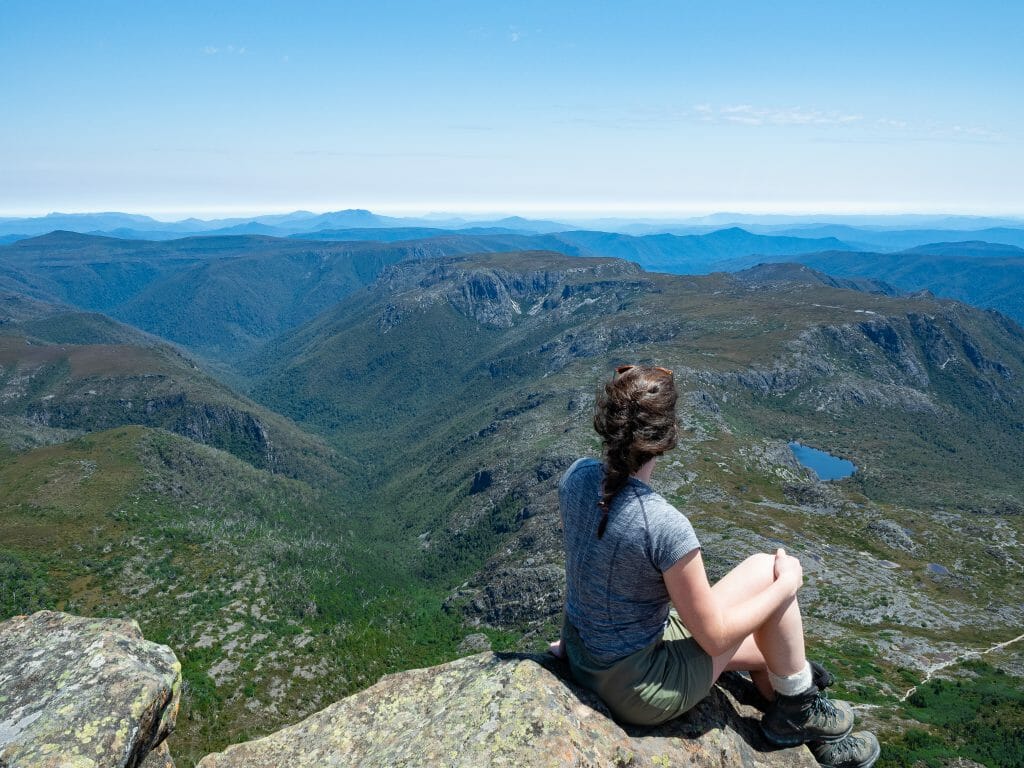
Head, hands & feet
Tasmania’s rapidly shifting weather means you’ll need to protect your extremities from sun, cold, rain, and wind— sometimes all on the same day. These pieces kept me warm, dry, and moving through the wild Tasmanian alpine.

sun hat: Arc’teryx Gamma 5-Panel Cap
I wore a light hat every day for sun protection. Breathable and easy to shove into a pocket when not needed!

sunglasses: Julbo Vermont
From glacier travel to rocky scrambles, these are my favourite outdoor sunglasses.

neck gaiter: Buff Original
Lightweight and versatile, a Buff is essential for protecting against daily sun, sweat, dust, and wind.

beanie: Arc’teryx Mallow Toque
A small beanie is an easy add to your camp outfit to stay warm as nighttime temps approach freezing.

lightweight hiking gloves: Outdoor Research Trail Mix Gloves (women’s) / (men’s)
Nice to have for chilly mornings or setting up camp in the wind. These were thin, breathable, and just warm enough without overheating my hands during movement.

waterproof shell mittens: Black Diamond Waterproof Overmitts
There’s always a chance of rain in Tassie, so bring a lightweight pair of waterproof shell mittens to layer over your fleece gloves for extra warmth and full weather protection.

2x liner socks: Injinji Liner Crew + REI Co-op Silk Liner Crew Socks
I wore my favourite toe-sock liners under my boot socks to reduce friction and prevent blisters throughout the trail.

2x boot socks: Darn Tough Hiker Micro Crew Cushion Socks (women’s) / (men’s)
My go-to socks for backpacking— durable, padded, and still comfy after multiple days of trail grime. I’d recommend 2 pairs of socks for this 6-day route.

camp shoes: Teva Original
Easy to slip on after hiking boots, great for giving feet a breather, and worked well for setting up camp and short bathroom walks.
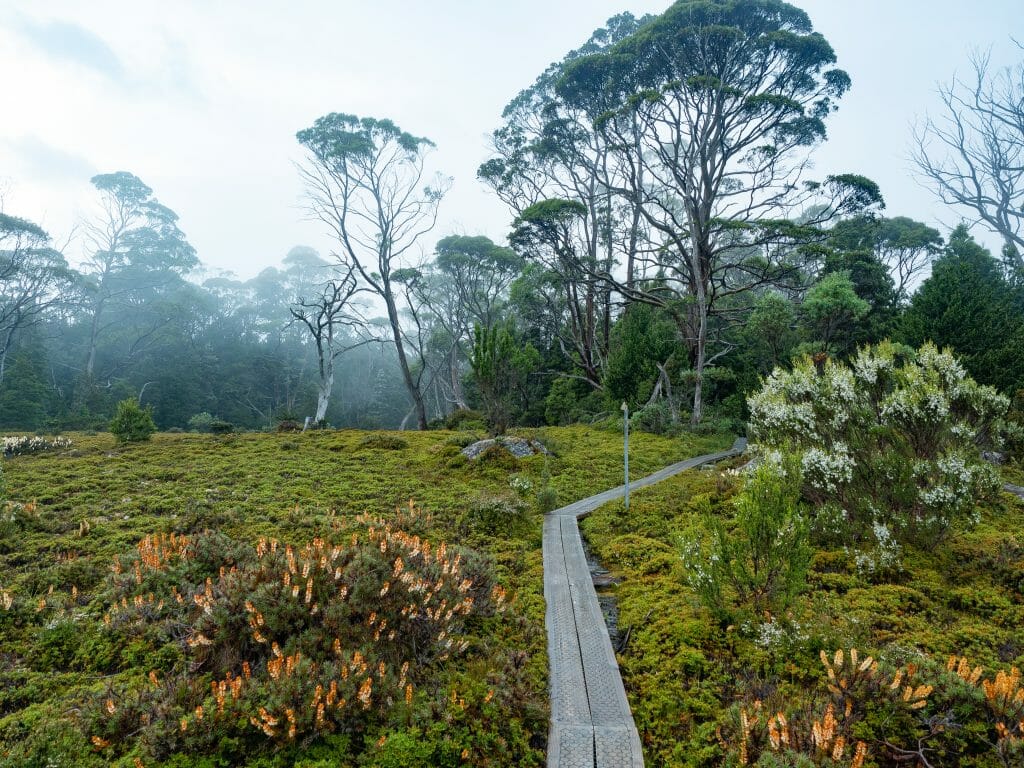
Personal items
A few lightweight essentials that made a huge difference for trail hygiene, sun protection, and overall sanity during 6 days in the Tasmanian wilderness.

toiletries + bathroom bits
Toothbrush, toothpaste, hairbrush, deodorant, medications, contact solution… whatever you need to stay clean and comfortable for multiple days on the trail!
For the wilderness bathroom, pack toilet paper, hand sanitiser, and a ziplock bag to pack out used items if needed.

Kula Cloth (for women)
This reusable antimicrobial pee cloth is designed specifically for backcountry female hygiene— it’s absorbent on one side, waterproof on the other, and treated with silver ions to resist bacteria growth and odour.
It’s easy to wash, dries fast, snaps shut for discretion, and clips onto the outside of your pack so it’s always accessible. Not only is it way more hygienic than carrying used toilet paper in a ziplock, but it also seriously reduces your trail waste, making it a no-brainer for sustainable hiking and women’s health on the go.

sun safety
Sun exposure builds quickly when you’re spending hours outside every day, especially in Australia (that ozone hole is no joke). Pack SPF 50+ sunscreen, SPF lip balm, and whatever else you need to stay sun-safe on the trail!

camera: Fujifilm x100vi
👉🏼 For a complete run-down of ALL the camera gear we are currently using & loving, check out this post: Camera gear for travel photography: what we use as full-time travellers
Trekking Tasmania’s Overland Track was a true highlight of my time on Australia’s island state— lush, rugged, remote, and full of unexpected beauty. This packing list helped me stay comfortable and prepared through all the weather and all the mud, and I hope it does the same for you.
⛰️ Still planning your hike? Don’t miss my Overland Track Guide for a detailed daily route description, trip logistics & real-world tips on tackling Tasmania’s best multi-day hike. And if you have any questions about gear, drop them in the comments, I’m always happy to help!
